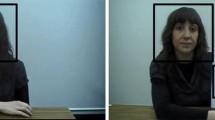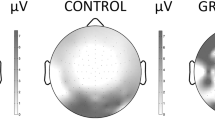Abstract
Selective attention to visual and auditory stimuli and reflection-impulsivity were studied in normal and learning-disabled 8- and 12-year-old boys. Multivariate analyses, followed by univariate and paired-comparison tests, indicated that the normal children increased in selective attention efficiency with age to both visual and auditory stimuli. Learning-disabled children increased in selective attention efficiency with age to auditory, but not to visual, stimuli. Both groups increased with age in reflection as measured by Kagan's Matching Familiar Figures Test (MFF). The 8-year-old learning-disabled children were more impulsive than the 8-year-old normals on MFF error scores, but not on MFF latency scores. No difference occurred between the 12-year-old learning-disabled and normal children on either MFF error or MFF latency scores. Correlations between the selective attention scores and MFF error and latency scores were not significant.
Similar content being viewed by others
References
Block, J., Block J. H., & Harrington, D. M. Some misgivings about the Matching Familiar Figures Test as a measure of reflection-impulsivity.Developmental Psychology, 1974,10, 611–632.
Brown, R. T., & Quay, L. C. Reflection-impulsivity in normal and behavior disordered children.Journal of Abnormal Child Psychology, 1977,5, 457–462.
Brown, R. T., & Quay, L. C.Hyperactive and normal children and the error, latency, and double median split scoring procedures of the Matching Familiar Figures Test. Paper presented at the meeting of the American Psychological Association, Toronto, 1978.
Campbell, S. B., Douglas, V. I., & Morgenstern, G. Cognitive styles in hyperactive children and the effect of methylphenidate.Journal of Child Psychology and Psychiatry, 1971,12, 55–67.
Douglas, V. Sustained attention and impulse control: Implication for the handicapped child. In C. E. Sherick et al. (Eds.),Psychology and the handicapped child (Department of Health, Education and Welfare Publication No. (OE) 73-05000). Washington, D.C.: U. S. Government Printing Office, 1974.
Drucker, J. F., & Hagen, J. W. Developmental trends in the processing of task relevant and task irrelevant information.Child Development, 1969, 40, 371–382.
Hagen, J. W. The effect of distraction on selective attention.Child Development, 1967,38, 685–694.
Hagen, J. W. Strategies for remembering. In S. Farnham-Diggory (Ed.),Information processing in children. New York: Academic Press, 1972.
Hallahan, D. P., Kauffman, J. M., & Ball, D. W. Selective attention and the cognitive tempo of low achieving and high achieving sixth grade males.Perceptual and Motor Skills, 1973,36, 579–583.
Hallahan, D. P., Kauffman, J. M., & Ball, D. W. Developmental trends in recall of central and incidental auditory materials.Journal of Experimental Psychology, 1974,17, 409–421.
Hartman, F. R. Single and multiple-channel channel communication: A review of research on a proposed model.Audio-Visual Communication Review, 1961,9, 235–262.
Kagan, J. Impulsive and reflective children: Significance of conceptual tempo. In J. D. Krumboltz (Ed.),Learning and the educational process. Chicago: Rand McNally, 1965.
Maccoby, E. E. Selective auditory attention in children. In L. P. Lippsitt & C. C. Spiker (Eds.),Advances in child development and behavior (Vol. 3). New York: Academic Press, 1967.
Maccoby, E. E., & Konrad, K. W. Age trends in selective listening.Journal of Experimental Child Psychology, 1966,3, 113–122.
Mercer, C. D., Hallahan, D. P., & Ball, D. W.Modeling and attention of mentally retarded,learning disordered, and normal boys. Unpublished paper, University of Virginia, 1976.
Mussen, P. H., Conger, J. J., & Kagan, J.Child development and personality (4th ed.). New York: Harper & Row, 1974.
Perelle, I. B. Effects of auditory and written-visual stimuli on learning and retention.Journal of Educational Technology Systems, 1972,1(3), 235–251.
Perelle, I. B. Difference in attention to stimulus presentation mode with regard to age.Developmental Psychology, 1975,11(3), 403–404.
Quay, L. C., Popkin, M., Weld, G. L., & McLeskey, J. Responses of normal and learning disabled children as a function of the stopwatch in the Matching Familiar Figures testing situation.Journal of Experimental Child Psychology, 1978,26, 383–388.
Author information
Authors and Affiliations
Additional information
This research was supported in part by BEH grant G007507227. The authors are indebted to Eleanor McCandless for her assistance in securing the learning-disabled subjects and to James McLeskey and Michael Popkin for their assistance in collecting and analyzing data.
Rights and permissions
About this article
Cite this article
Quay, L.C., Weld, G.L. Visual and auditory selective attention and reflection-impulsivity in normal and learning-disabled boys at two age levels. J Abnorm Child Psychol 8, 117–125 (1980). https://doi.org/10.1007/BF00918166
Issue Date:
DOI: https://doi.org/10.1007/BF00918166




